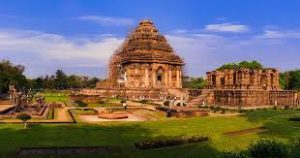Konark Sun Temple : Study

The Archaeological Survey of India (ASI) has prohibited tourists from entering the ‘Nata Mandap’ of the Konark Sun Temple in Odisha’s Puri district.
- Konark Sun Temple is located on the coastline of Odisha in the Puri district.
- Also called the Surya Devalaya, the temple is dedicated to the Hindu sun god Surya.
- Textual evidence indicates that Narasimha I (who reigned between 1238 and 1264) of the Eastern Ganga dynasty built the temple in 1250 CE.
- It was designated a UNESCO World Heritage Site in 1984.
- It is a classic example of the Odisha style of architecture, or Kalinga architecture.
- The height of the Sun Temple at Konark is estimated to be around 227 feet, making it one of the tallest temples ever built in the country.
- The temple complex has the appearance of a 100-foot-high solar chariot, with 24 wheels and pulled by six horses, all carved from stone.
- It is oriented towards the east so that the first rays of the sunrise strike the main entrance.
- The wheels of the temple are sundials, which can be used to calculate time accurately to a minute.
- Around the base of the temple, there are images of animals, foliage, warriors on horses, and other interesting structures.
- The temple also features elaborate stone carvings depicting scenes from Hindu mythology.
- The temple was constructed using three types of stones – the laterite stone for the boundary walls, flooring, and staircase; Khondalite for the structure; and Chlorite stone for the door jams and lintel.
- The use of iron strips to hold the structure together can be seen amongst the ruins of the temple.
- The temple was called Black Pagoda, attributed to its dark facade, by the Europeans who used it for navigation for their ships.
- It is said that the temple could draw ships to the shore due to its magnetic powers.
- The temple remains a site of contemporary worship for Hindus, during the annual Chandrabhaga Festival, around the month of February.




